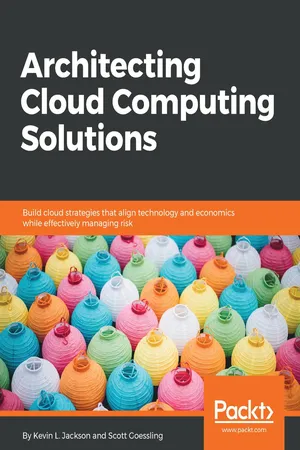
Architecting Cloud Computing Solutions
Build cloud strategies that align technology and economics while effectively managing risk
- 378 pages
- English
- ePUB (mobile friendly)
- Available on iOS & Android
Architecting Cloud Computing Solutions
Build cloud strategies that align technology and economics while effectively managing risk
About this book
Accelerating Business and Mission Success with Cloud Computing.About This Book• A step-by-step guide that will practically guide you through implementing Cloud computing services effectively and efficiently. • Learn to choose the most ideal Cloud service model, and adopt appropriate Cloud design considerations for your organization.• Leverage Cloud computing methodologies to successfully develop a cost-effective Cloud environment successfully.Who This Book Is ForIf you are an IT Administrator, Cloud Architect, or a Solution Architect keen to benefit from cloud adoption for your organization, then this book is for you.Small business owners, managers, or consultants will also find this book useful. No prior knowledge of Cloud computing is needed.What You Will Learn• Manage changes in the digital transformation and cloud transition process• Design and build architectures that support specific business cases• Design, modify, and aggregate baseline cloud architectures• Familiarize yourself with cloud application security and cloud computing security threats• Design and architect small, medium, and large cloud computing solutionsIn DetailCloud adoption is a core component of digital transformation. Scaling the IT environment, making it resilient, and reducing costs are what organizations want. Architecting Cloud Computing Solutions presents and explains critical Cloud solution design considerations and technology decisions required to choose and deploy the right Cloud service and deployment models, based on your business and technology service requirements.This book starts with the fundamentals of cloud computing and its architectural concepts. It then walks you through Cloud service models (IaaS, PaaS, and SaaS), deployment models (public, private, community, and hybrid) and implementation options (Enterprise, MSP, and CSP) to explain and describe the key considerations and challenges organizations face during cloud migration. Later, this book delves into how to leverage DevOps, Cloud-Native, and Serverless architectures in your Cloud environment and presents industry best practices for scaling your Cloud environment. Finally, this book addresses (in depth) managing essential cloud technology service components such as data storage, security controls, and disaster recovery. By the end of this book, you will have mastered all the design considerations and operational trades required to adopt Cloud services, no matter which cloud service provider you choose. Style and approachThis book will teach you how to architect effective and organizationally aligned Cloud computing solutions by addressing Cloud computing fundamentals, Cloud architecture considerations, Cloud technology service selection, and Cloud computing security controls.
Frequently asked questions
- Essential is ideal for learners and professionals who enjoy exploring a wide range of subjects. Access the Essential Library with 800,000+ trusted titles and best-sellers across business, personal growth, and the humanities. Includes unlimited reading time and Standard Read Aloud voice.
- Complete: Perfect for advanced learners and researchers needing full, unrestricted access. Unlock 1.4M+ books across hundreds of subjects, including academic and specialized titles. The Complete Plan also includes advanced features like Premium Read Aloud and Research Assistant.
Please note we cannot support devices running on iOS 13 and Android 7 or earlier. Learn more about using the app.
Information
Hands-On Lab 1 – Basic Cloud Design (Single Server)
Hands-on labs and exercises
Complexity
Eliminating the noise

Burstorm lab 1 – background (NeBu Systems)
Burstorm lab 1 – getting started
- (Required) current ...
Table of contents
- Title Page
- Copyright and Credits
- Contributors
- Packt Upsell
- Preface
- Prologue
- What is Cloud Computing?
- Governance and Change Management
- Design Considerations
- Business Drivers, Metrics, and Use Cases
- Architecture Executive Decisions
- Architecting for Transition
- Baseline Cloud Architectures
- Solution Reference Architectures
- Cloud Environment Key Tenets and Virtualization
- Cloud Clients and Key Cloud Services
- Operational Requirements
- CSP Performance
- Cloud Application Development
- Data Security
- Application Security
- Risk Management and Business Continuity
- Hands-On Lab 1 – Basic Cloud Design (Single Server)
- Hands-On Lab 2 – Advanced Cloud Design Insight
- Hands-On Lab 3 – Optimizing Current State (12 Months Later)
- Cloud Architecture – Lessons Learned
- Epilogue
- Other Books You May Enjoy